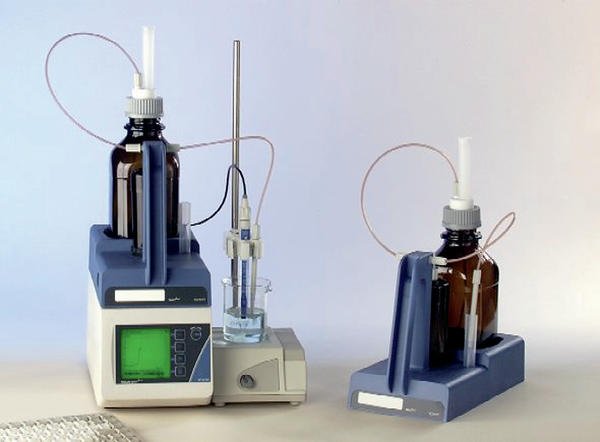Using titration to monitor the quality of the production process has many advantages. The analysing method is easy to accomplish and delivers fast, reliable and precise results. The effort for implementation is fairly low; a complete laboratory is not needed. The process is universally suitable, not only in the pharmaceutical and chemical industries, but also in the food industry, environmental engineering and galvanics.
Dr. Jürgen Peters
Today, titration is easy and uncomplicated even in shift operation. A sample is taken during production, inserted into a beaker with water and placed on a magnetic stirrer of an automatic titrator, e.g. TL alpha plus from Schott Instruments. After starting, a suitable reagent is dosed until the end of titration is recognised by a sensor. The titrator calculates the concentration from the dosed volume. Titration is an absolute method. The analysed result is directly retrieved from the molar mass of all substances involved. Calibration is not necessary and standard equipment is sufficient. The application is generally straightforward and delivers a fast result. Titration is an especially rugged process; modern instruments have proved themselves under difficult conditions by operating for many years. Several determination methods have been tested for different applications. The concentration range for trace contents can reach 100 %. Examples include determinations of the content of pharmaceutical agents, the concentrations of acids and bases as well as water and chloride titration in foodstuffs, major and minor components in a variety of raw materials and products in the chemical industry or drinking water, waste water, soil and sludge analyses. Galvanics represents a good instance of the use of automatic titration. The quality parameters can be identified without a laboratory and close to production, where skilled laboratory workers are normally not available. A large number of cleaning, activation and coating baths are employed in galvanics. The components can be metals that serve as coatings or dissolved from metals. Many baths contain very highly concentrated acids or alkalis that need a specific concentration to develop their full effect.
The TL alpha plus automatic titrator is a compact unit with only a small number of user keys, a precise dosing system, a reagent bottle and an integrated magnetic stirrer. A sensor dipped into the solvent detects the end of titration. The result is automatically calculated from the used reagent and documented. The samples should be taken in real time during production for direct titration. Contrary to popular belief, the unit can be installed almost anywhere. Even fully automised titration with a sample changer and a PC takes up only a small amount of space in the production area. Although there is no disadvantage in protecting the production equipment, this is not essential.
Reliable and retraceable
If the unit is operated using a PC, all results can be stored in a database and retrieved again at any time. Without a PC, the analysis information can be automatically printed and documented. The initial investment in a sample changer is recuperated in approximately one year provided that at least ten samples are taken a day. What’s more, the device offers excellent reproducibility. The titrator is operated directly on the instrument, where the method can be selected and a sample description specified. Several predefined sample lists are available on the PC. Every single titration is retraceable in the database and can be retrieved and repeatedly calculated. Correct and reliable results are achieved with the help of various quality assurance measures:
- The titration system is set up by the manufacturer at the place of work; all methods and corresponding tests are implemented.
- At least one user receives thorough training.
- There is a standard for each titration reagent that defines the content and the monitoring time frame, e.g. every 30 or 50 titrations in the form of an additional titration.
- The electrodes are tested regularly with buffers. The tests are documented and can be traced at any time. If complete titration curves are recorded and stored, they can also be used to evaluate the sensor quality.
- The correctness of the work process is reviewed from time to time, e.g. in the framework of maintenance contracts. The accuracy of the dosing system is verified according to ISO 8655. The usual interval is one year, provided that the reagents are regularly tested.
- The accuracy of the pipettes is also checked at defined intervals (approximately every 6 months).
cpp 450
Products
Analytica-Portal
Share:







